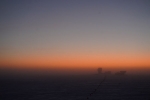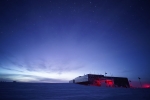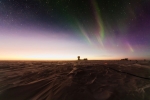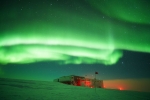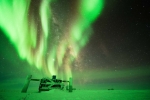The sky is beginning to take on different colors at the Pole, depending on which direction you’re looking. There’s a hazy band of orange along the horizon, but facing away toward the station the sky appears blue.
It was a quiet week at the Pole. And with some bad weather, it was a good time to roam around and take some indoor photos.
It’s a slow sunrise at the South Pole, with light creeping up from the horizon little by little each day. But even as the twilight approaches and the sky brightens, it’s still dark enough to discern some auroras here and there.
Sometimes the moon is so bright at the Pole that it lights up the dark winter skies. The moon was setting last week, and as it left there was a slow transition to the first visible signs of sunlight along the horizon.
The auroras were still out in full force last week, as if lingering in their farewell before twilight steps up.
That’s a lot of green!—it looks like a backdrop fit for Wicked. But views like this, of strong auroras over the IceCube Lab (ICL), will soon be gone, so the winterovers are capturing the night sky while they still can.
From July 22-24, the Multimessenger Diversity Network (MDN) met at the Wisconsin IceCube Particle Astrophysics Center, located at the University of Wisconsin–Madison, the lead institution of the IceCube Neutrino Observatory.
Last week was a mostly quiet one at the South Pole station. With winds blowing up to 40 knots for the early part of the week, people were trying to stay indoors.
It was a busy week all around at the Pole. The IceCube detector itself had a few issues for the winterovers to attend to, while the final week of the Polympics kept them busy as well.
The second annual Polympics (Pole Olympics) began last week at the Pole. This event is a modern competition that includes not only sports but also e-sports and other contests, like sled pulling.

